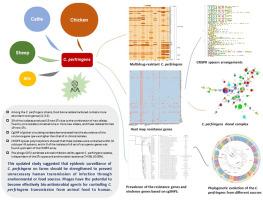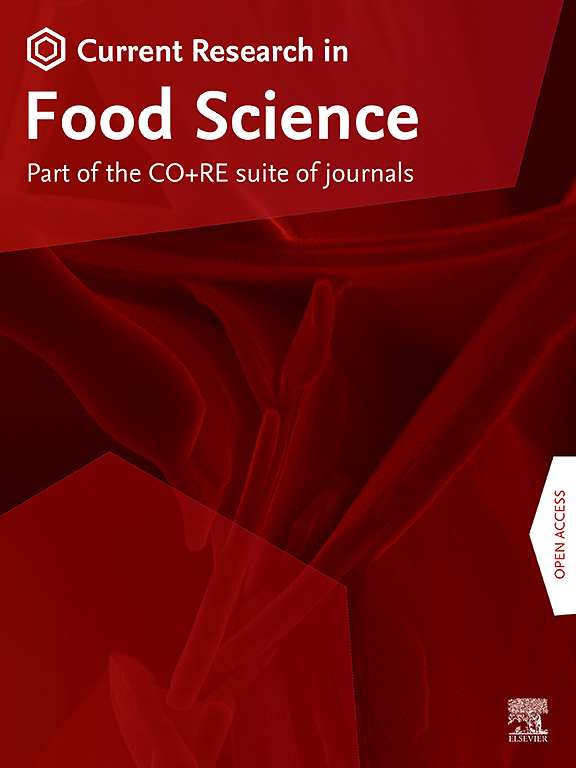用于追踪食用动物源性产气荚膜梭菌遗传多样性和多药耐药性的基因组MLST方案
IF 7
2区 农林科学
Q1 FOOD SCIENCE & TECHNOLOGY
引用次数: 0
摘要
产气荚膜梭菌是一种重要的食源性厌氧细菌,可引起人类和动物的慢性疾病。它产生的复杂毒素会导致腹泻、坏死性肠炎,甚至死亡。本研究旨在通过全基因组测序(WGS)和生物信息学分析,评估产气荚膜荚膜杆菌不同菌株中抗生素耐药基因的存在和毒素产生的决定因素,这些菌株来自不同的地理位置和动物来源。抗微生物药物耐药性检测显示,分离株的耐药性普遍存在,其中39.5%对克林霉素耐药,32.6%对四环素耐药。此外,发现29.1%的分离株对至少两类常用抗生素具有耐药性。与四环素耐药相关的TetA(P)和tetB(P)是最常见的耐药基因,分别出现在93.0%和79.0%的分离株中。在85株分离株中检测到编码细胞外胶原酶(colA和colSI)、α毒素(plc)和唾液酸酶(nanH)的毒力基因,占所有测序菌株的99%。值得注意的是,产气荚膜荚膜杆菌肠毒素(cpe)的编码基因仅在一株来自鸡的分离物中被鉴定出来。多位点序列分型结果显示,86株代表性分离株属于49种序列类型(STs),其中包括33种独特的、以前未被鉴定的STs。此外,30.23%的STs被分成6个克隆复合物(CCs)。对全球流行的分离株进行的CgSNP分析表明,这些分离株中毒力基因cpe的流行率高于临床菌株。耐多药和toxin-encoding基因的识别中隔离,突显出c . perfringens有关抗菌素耐药性的传播影响动物和人类。CRISPR/Cas系统的多样性为致病性产气荚膜荚膜菌复杂的遗传相关性和进化动力学提供了新的见解。值得注意的是,噬菌体SD72对产气荚膜荚膜杆菌分离株具有广泛的抑制作用,与STs类型和抗菌素耐药性无关(74/86,80.1%)。这些发现突出表明,迫切需要加强牲畜环境中产气荚膜梭菌的流行监测,以减轻通过环境或食物来源向人类传播的风险。此外,噬菌体作为控制产气荚膜荚膜杆菌从动物传播给人类的生物抗菌剂提供了一条有前途的途径。本文章由计算机程序翻译,如有差异,请以英文原文为准。

Genome MLST scheme for tracing genetic diversity and multidrug resistance of food animal-derived Clostridium perfringens
Clostridium perfringens is an important food-borne anaerobic bacterium that can cause chronic disease in humans and animals. The complex toxins that it produces can cause diarrhea, necrotizing enteritis, and even death. This study aimed to evaluate the presence of antibiotic resistance genes and determinants of toxin production in various strains of C. perfringens, derived from different geographical locations and animal sources, through whole-genome sequencing (WGS) and bioinformatics analysis. Antimicrobial resistance testing revealed a notable prevalence of resistance among isolates, with 39.5 % being resistant to clindamycin and 32.6 % resistant to tetracycline. Additionally, 29.1 % of the isolates were found to be resistant to at least two classes of commonly used antibiotics. TetA(P) and tetB(P), associated with tetracycline resistance, were the most frequently identified resistance genes, present in 93.0 % and 79.0 % of the isolates, respectively. Virulence genes encoding extracellular collagenases (colA and colSI), alpha-toxin (plc), and sialidase (nanH) were detected in 85 isolates, representing 99 % of all sequenced strains. Notably, the gene encoding C. perfringens enterotoxin (cpe) was identified in only one isolate, which originated from chicken. Multi-locus sequence typing revealed that the 86 representative isolates belonged to 49 sequence types (STs), including 33 unique, previously uncharacterized STs. Furthermore, 30.23 % of these STs were grouped into six clonal complexes (CCs). CgSNP analysis of globally circulating isolates demonstrated that the prevalence of the virulence gene cpe was higher in these isolates than in clinical strains. The identification of multi-drug resistance and toxin-encoding genes among the isolates underscores the concerning spread of antimicrobial resistance among C. perfringens affecting both animals and humans. The diversity of CRISPR/Cas system provided addition insight into complex genetic correlations and evolutionary dynamics of pathogenic C. perfringens. Notably, the phage SD72 exhibited a broad inhibitory effect against C. perfringens isolates, irrespective of STs types and antimicrobial resistance (74/86, 80.1 %). These findings highlight the urgent need for enhanced epidemic surveillance of C. perfringens in livestock settings to mitigate the risks of human transmission via environmental or food sources. Additionally, bacteriophages present a promising avenue as bio-antimicrobial agents for controlling the transmission of C. perfringens from animal sources to humans.
求助全文
通过发布文献求助,成功后即可免费获取论文全文。
去求助
来源期刊

Current Research in Food Science
Agricultural and Biological Sciences-Food Science
CiteScore
7.40
自引率
3.20%
发文量
232
审稿时长
84 days
期刊介绍:
Current Research in Food Science is an international peer-reviewed journal dedicated to advancing the breadth of knowledge in the field of food science. It serves as a platform for publishing original research articles and short communications that encompass a wide array of topics, including food chemistry, physics, microbiology, nutrition, nutraceuticals, process and package engineering, materials science, food sustainability, and food security. By covering these diverse areas, the journal aims to provide a comprehensive source of the latest scientific findings and technological advancements that are shaping the future of the food industry. The journal's scope is designed to address the multidisciplinary nature of food science, reflecting its commitment to promoting innovation and ensuring the safety and quality of the food supply.
 求助内容:
求助内容: 应助结果提醒方式:
应助结果提醒方式:


